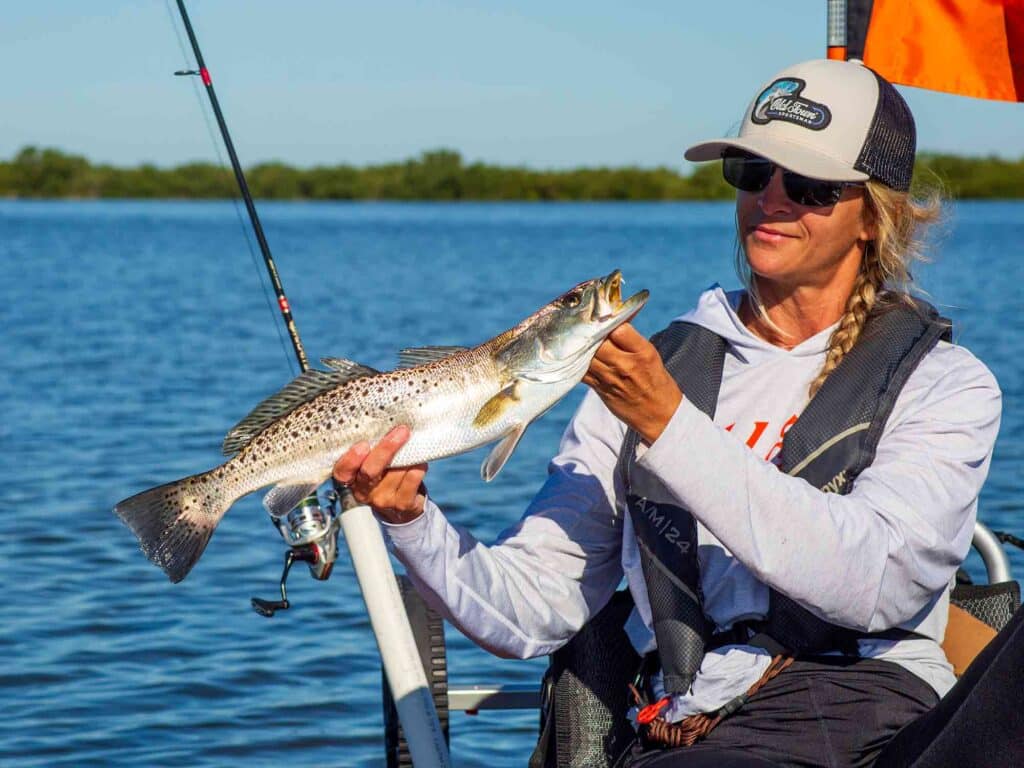
I doubted the popping cork. What a mistake that was.
It was an autumn morning that’d make anyone from Ohio or the Northeast want to move to Florida. No jackets or rain gear necessary. Just sunshine, clear-water shallows and two kayakers in search of redfish, speckled seatrout and snook. I met professional kayak bass angler and Old Town pro staffer Wendy Biles at the launch for a day of fishing the flats of Florida’s Mosquito Lagoon. My goal was to experiment with Old Town’s PDL Drive, a propulsion system that I had tried at various trade shows over the years but never actually fished in a saltwater environment.
Biles trailered her Old Town Sportsman Salty PDL 120 (12-footer) and Sportsman PDL 106 yaks over to the coast for us to use. The watercraft company recently unveiled its BigWater ePDL kayak, with a propulsion drive that’s pedal- or battery-powered, but those kayaks aren’t available until early 2024. I hopped into the 10.5-footer and we headed south along the Intracoastal Waterway (ICW), against the tide and toward the skinny bays that make this waterscape unique.
Biles explained how to engage the rudder, control the steering, and move my comfy seat farther away from the drive to accommodate my long legs. Biles didn’t have any electronics rigged — we didn’t need them for the lagoons — but she mentioned they’re easy to mount yourself, especially with a couple accessories from YakAttack. I tried standing up and realized quickly the kayak was going to excel at sight fishing. The pedal drive, with its bicycle pedals and durable prop, felt extremely sturdy as I found my rhythm. The top of the PDL drive has a dry storage compartment where I stowed my phone.
Pretty soon, I nearly forgot I was pedaling at all.
“People ask how I’m able to pedal 5 or 6 miles from the launch,” said Biles. “It’s because pedaling this kayak is so easy. You can pedal all day and not get worn out. I enjoy the exercise over a trolling motor, and yet I’m still not exhausted at the end of the day.”
Fishing Mosquito Lagoon
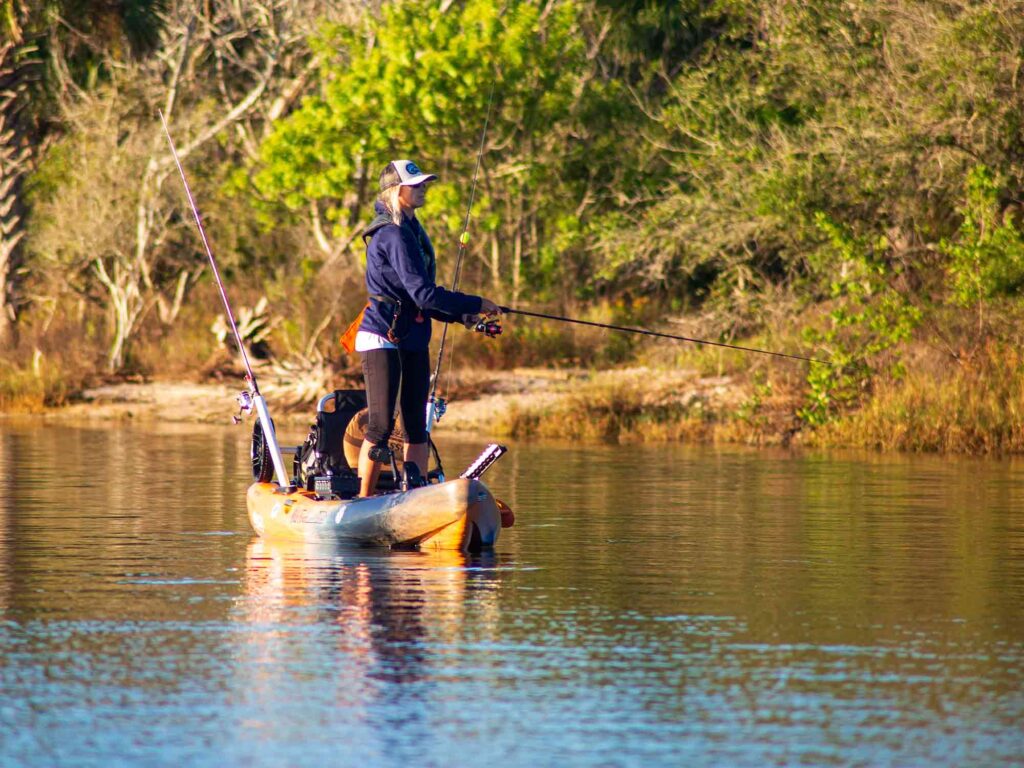
At the first shoreline we drifted, glass minnows and mullet were schooled up in different circles. Nearby, an osprey bombed a baitfish school with remarkable precision and energy. Every time, it sounded like someone hurled a rock off a cliff — nope, just a fish hawk getting a meal. A pod of dolphins was next to join the shenanigans, with some that could only be a couple months old. Still, they had no problem flipping out of the water and playing with their breakfast.
“I’ve had good luck here with seatrout in the morning,” said Biles. “Don’t get right up against the shoreline. Stay farther out where there’s a couple feet of water. There’s no water depth right next to the shore.”
Biles stood up in her kayak as she worked a topwater. Meanwhile, I cast out a shad-tail jig the size of my thumb. In my experience, dolphins can shut down a bite very quickly, so I convinced Biles to move on to another spot. The only fish we left biting were a couple of ladyfish.
Top Shallow Water Flats Fishing Lures
As the day progressed, we pedaled from one location to another, figuring out the best conditions where redfish and seatrout were holding. What stood out about the Sportsman PDL kayaks was its ability to navigate in shallow water. And that’s where the fish congregate in Mosquito Lagoon. The deeper waters (2 plus feet) serve as running lanes for skiffs and jon boats, but when it’s time to fish, anglers head to less than a foot of water.
The PDL drive itself locks into place, especially for traversing big water and waves — situations where the drive shouldn’t accidentally pop up. But I purposely left a single latch unlocked on the drive, to allow the drive to disengage if it hits a shallow sand bar. Thankfully, I never bumped anything with the drive, which shows just how shallow the yaks can fish.
Five lures stood out to us throughout the day, some performing better than others. But all five should be ready to cast when fishing the lagoon system, in my opinion.
Working the Popping Cork
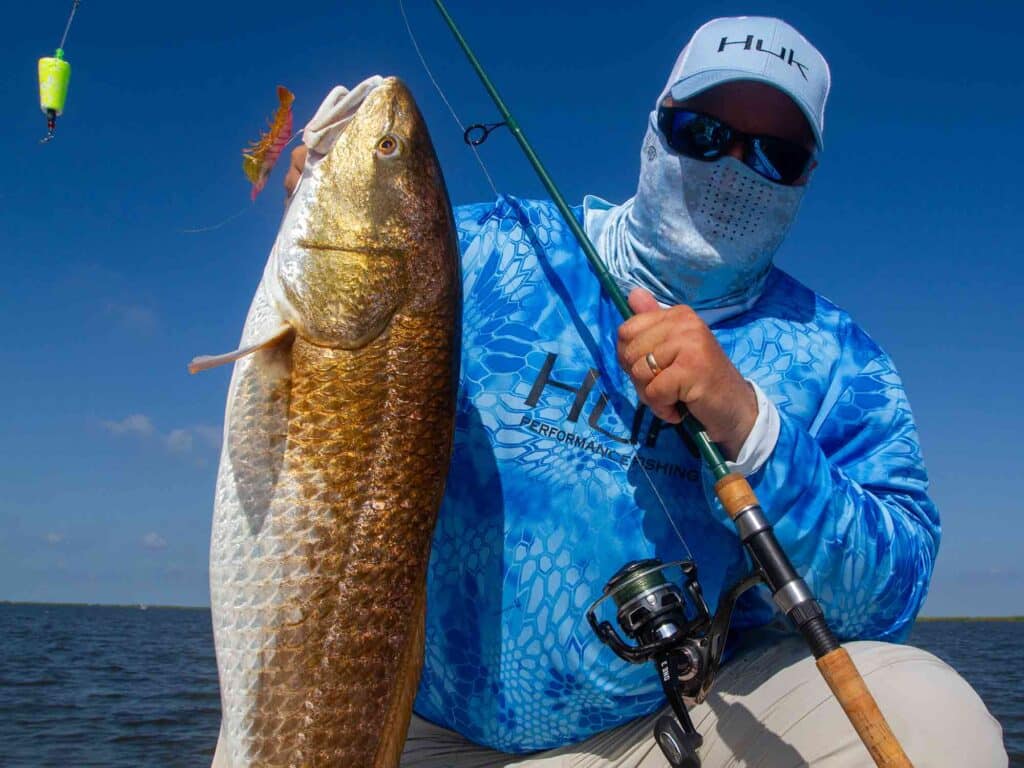
Biles and I joked that using a popping cork is like riding a bicycle with training wheels. But I learned quickly not to rag on such a dependable presentation. I’m not against using popping corks. I’ve caught some of my biggest red drum in Louisiana using popping corks, paired with a paddle tail or shrimp soft-plastic. I thought clear water wasn’t a great place to use the corks, especially for the spooky fish in the lagoon. This old dog learned something new.
“I can always rely on the popping cork to catch trout,” said Biles. “But near the mangroves, I catch snook on them too.”
Biles was on a tear, catching speckled seatrout at just about every stop. We were fishing clear water about 18 inches deep, with a scattered sand and shoal grass bottom. Approximately a foot below the cork, she tied on a jig with a white shad tail in the Slim Shady color. Biles worked the rig methodically in the clear water, at times watching the cork plunge underwater when she wasn’t reeling. The specks were hitting the bait on the drop.
At one point in a shallow pocket, Biles was shadowing a school of baitfish, plucking seatrout out of the mix. Then, she hooked one bigger than the others. “I just noticed movement at the water’s surface,” she said. “That slight difference, I knew there was a bigger fish there.” When the bait hit the water, the fish ate almost immediately, and Biles quickly fought and released our biggest trout of the day. In total, Biles probably caught a double-digit number of seatrout.
Pick Your Moments with Topwater Plugs
This is an all-or-nothing lure. On this day, I only gained the attention of “dink” trout that weren’t able to find the hook. The plug works best at daybreak, before the winds pick up and stir the flats. That morning, I cast a Berkley Cane Walker, with a cupped face that also walks the dog. I love baits like this because of the side-to-side action coupled with its ability to throw and splash water. When the bite is on, speckled trout and red drum will suck the baits down willingly. Bonus catches include snook and tarpon, especially near deeper channels with mangroves nearby.
But in Mosquito Lagoon, I can’t always rely on the morning or dusk bite, even if conditions seem perfect. I always have the bait tied on at first light, but if it isn’t happening within half an hour I’ll switch to other confidence lures.
The Reliable Jig and Paddle Tail
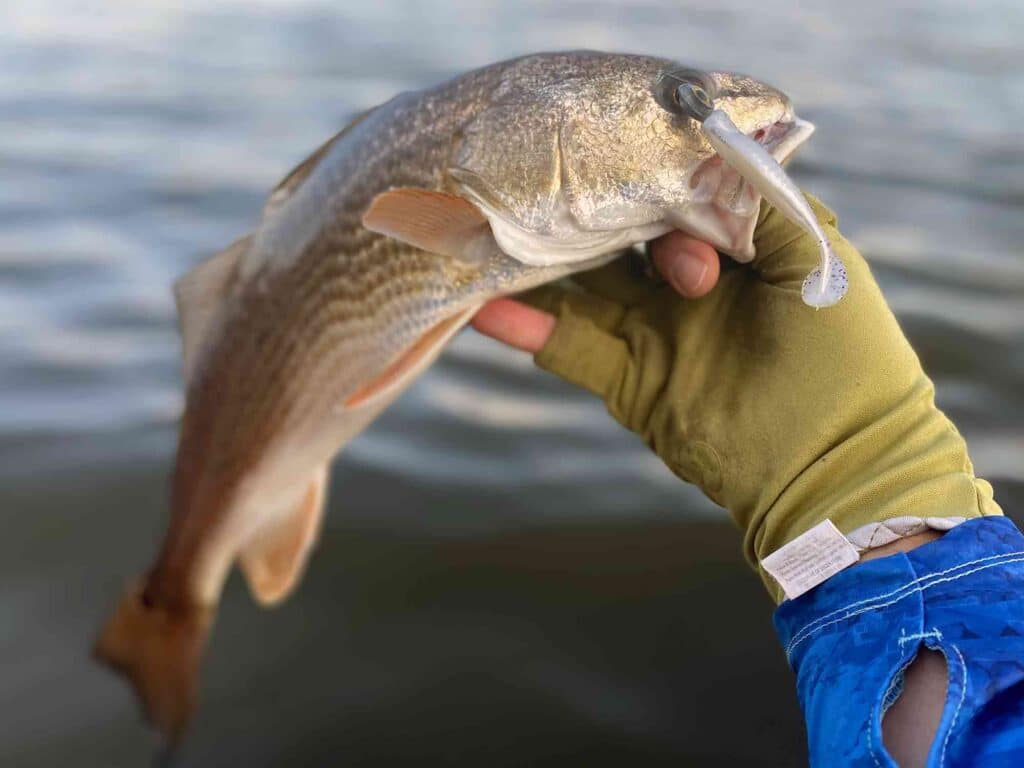
This is the ultimate search bait for blind-casting an area. Biles was casting the popping cork while I cast this rig. If the fish are there, they will usually bite. Don’t be afraid to use a small bait too. My rig consisted of an 1/8-ounce Trout Eye jighead from Z-Man and a Berkley Powerbait Champ Swimmer (3 inches long).
Everything eats the jig reliably, except perhaps black drum. Cast the jig and retrieve it slowly. Add sporadic, short jerks or pops to allow the bait to rise and fall in the water column. More often than not, slower retrieves are better than fast. If the grass is fouling the hook, I’ll switch to weedless presentations.
Rigging Weedless Plastics
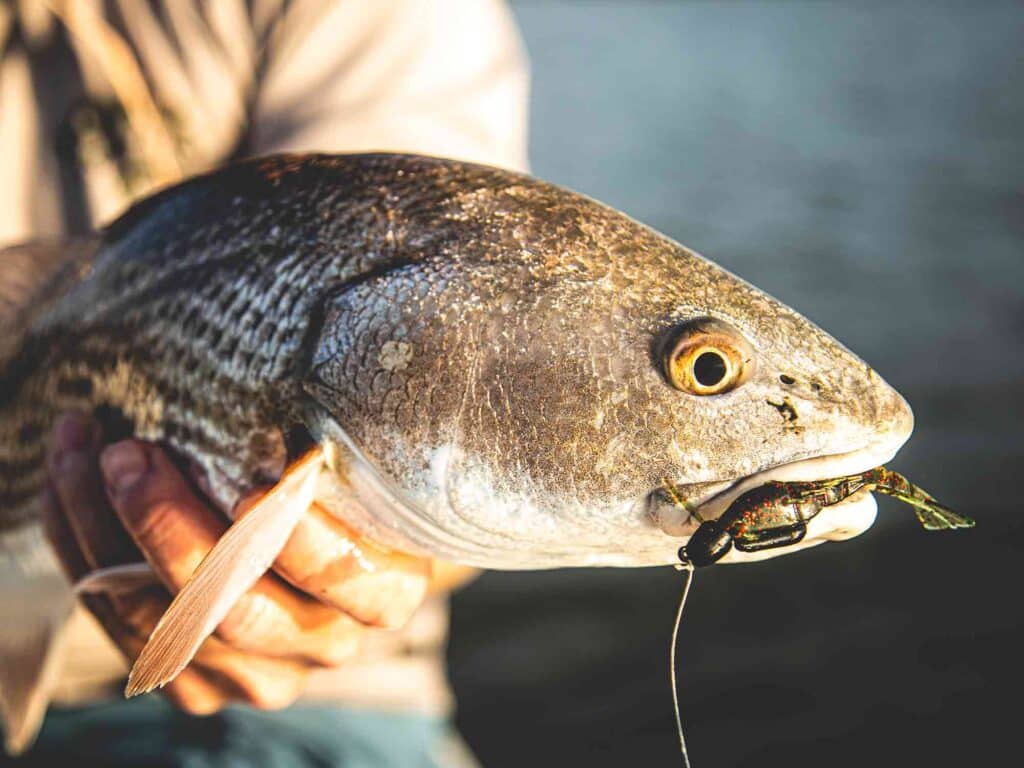
Besides grass flats, Mosquito Lagoon has plenty of mangrove shorelines. And seatrout, redfish and snook will often hug the shoreline, especially on a high tide. A low tide pushes fish off the shoreline, but high tides suck them back in. Blue crabs and finger mullet call mangroves home.
The absolute best bait to throw under mangroves is a weedless soft plastic rigged on a worm-style hook. Baits such as the Z-Man DieZel Minnowz and Jerk Shadz are my favorite lures to throw. And since Z-Man lures float, I’ll use a weighted hook like a TT Lures ChinlockZ or Pro BulletZ to get the bait to skip under the overhangs.
Finding shorelines holding fish in Mosquito Lagoon is not always easy. This is where the Old Town kayak excelled, possibly even more so than a skiff in this situation. Standing up in the yak, I used my paddle or pushpole to slowly meander down a fishy looking stretch. My intent was to spook one fish off the shoreline before casting. If there’s one fish there, often more fish are grouped along the same shoreline.
When I do spook a redfish or snook off the shoreline, I’ll move away from the mangroves and set up a drift. Well, first, I’ll curse myself if it’s a snook, because there aren’t a ton of those around. That’s when I’ll pepper casts to mangroves and open holes along the shore, looking for ambushing gamefish.
Scented Soft Baits for Sight Fishing
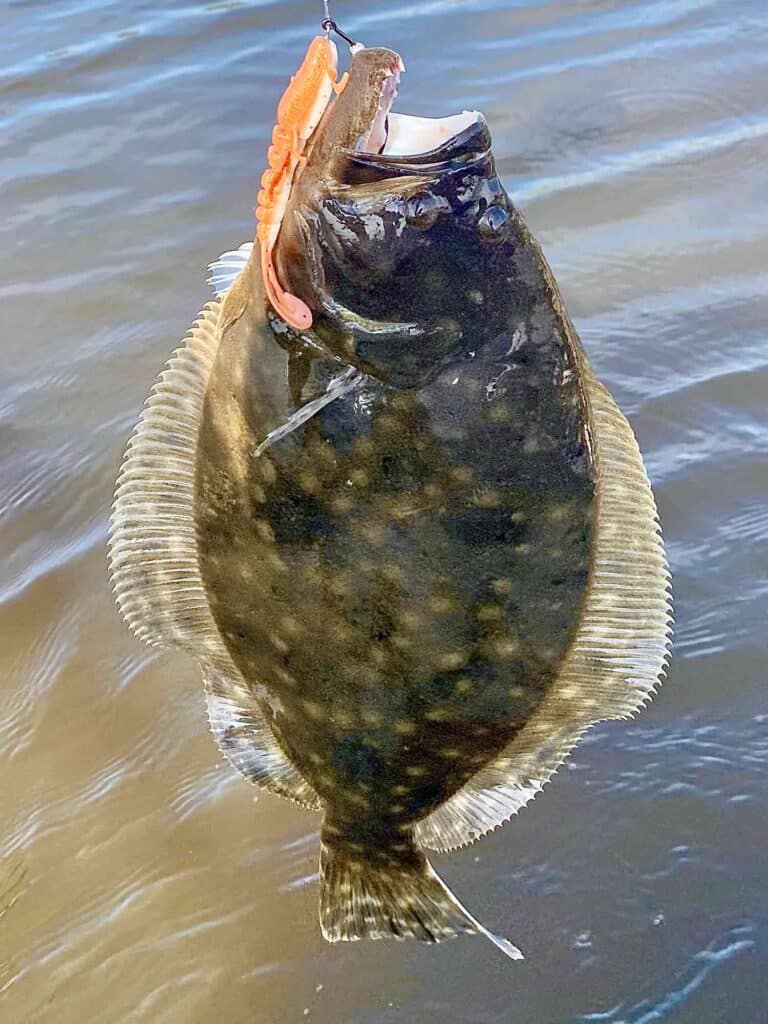
But my favorite style of flats fishing is sight fishing for reds. And that requires stinky baits and incredible stealth. Mosquito Lagoon redfish will school up at times. More often than not, if you don’t spook the school, you can hook numerous fish out of it using almost any saltwater lure. But the reds will run and pull drag during the fight, eventually breaking up the school.
Reds will also find flats and shorelines where they’ll just congregate and sit. Not schooled tightly, but fish here and there. Literally, they won’t move in the water and you can easily pass right by them. Too many anglers run their boats full throttle past fish, oblivious to their whereabouts. Sometimes, a fish will tail in the water, giving away its position. The last spot Biles and I fished had a number of reds staged along on a single flat.
“There are reds everywhere,” she said. “And it’s so easy to see them if you’re standing up and know what to look for. As a bass angler, I’m not really used to this style of fishing.”
In situations like this, have a very smelly bait such as a Berkley Gulp! or soft bait smothered in scent. I rig mine weedless, so I don’t mess up the presentation by snagging grass. Stand tall in your kayak, relying on quality polarized glasses, to spot motionless fish out in front and to the sides. If you spot a redfish, quickly trade the pushpole for the fishing rod. Cast the bait out, not directly on top of the fish, but so that the fish is able to find it. Often, a redfish might start swimming slowly in one direction, and your goal is to have that red swim directly toward your bait. This is when scent becomes so important — I’ve found that I get the most redfish bites when I retrieve the bait and let it drop directly in front of the redfish. If that drum is hungry, they’ll smell the bait and nose down on the lure. If a redfish notices a lure speeding toward them unnaturally, they’ll blow off the flat like a rocket.
Headed back to the launch, this time against steady winds that picked up after lunchtime, we really got to put the PDL drive to the test. It performed like a champ. “There’s so much water to fish here,” said Biles. “I usually don’t head south; I’m almost always fishing north, exploring new waters. Maybe we’ll head that way next time.”









